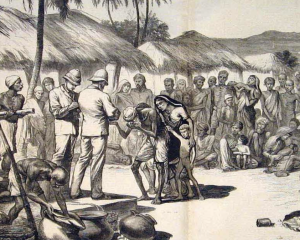January 1901 -- the dawn of the British Empire's fourth century. Few of its servants or rulers imagined it would be its last.
1901年1月,大英帝国第四个世纪的开端。英国与其殖民地几乎都未曾料到这将是帝国的最终纪。
Queen Victoria was barely cold in her coffin when her Viceroy of India, Lord Curzon, envisioned a fitting memorial in Calcutta to the Queen Empress who reigned over a fifth of the globe.
维多利亚女王刚刚辞世,印度总督寇松勋爵就已想好在加尔各答建造一座纪念碑,献给这位曾统治世界五分之一疆域的女皇。
A learned enthusiast of Indian architecture, Curzon's mind naturally turned to the most beautiful memorial in the world, the Taj Mahal.
作为一位热衷于印度建筑的博学之士,蔻松自然想到了世间最美丽的纪念碑,泰姬陵。
Not least because he'd been responsible for making it beautiful again, cleared out the bazaar in front of it, restored its water gardens.
不仅是因为在他的主持之下泰姬陵获得了新生,门前的集市被清除,水上花园被修复。
Now he would build the British Taj, faced with the same white marble hewn from the Makrana quarries.
现在他将打造英国版的泰姬陵,原料同样来自马克拉纳采石场的大理石。
But the Victoria memorial would not be a poem in stone so much as a proclamation in domes and columns that the British Raj was the Rome of the modern age.
但是维多利亚纪念堂不仅是一段由石块谱写的诗篇,它还用屋顶和柱子向世界宣告,英属印度就是现代的罗马。
But was this a time to be spending a royal fortune when millions of peasants were starving?
但在数百万农民挨饿的同时,大肆挥霍国库合适吗?

When the foundation stone was laid, a year after Curzon left India, with its violence and chaos, at least 16 million Indians had perished in the most terrible succession of famines Asia had known for centuries. What had happened?
在蔻松离开印度的一年后,纪念堂开始奠基,这时印度充斥着暴力和混乱,至少1600万印度人死于亚洲数世纪以来最严重的大饥荒。发生了什么?
The men and women who had sat at their desks, played out their chukkas and danced in the club were not monsters of hard-hearted indifference.
坐在桌前的男女们,玩弄着高帮皮马靴,在俱乐部跳舞,他们并不是铁石心肠的魔鬼。
They had, many of them, only the very best of intentions. They had in fact a vision that their empire was the best the world had ever seen because it was built on virtue.
他们中大多数都心怀善意。他们幻想着他们的帝国是世界上最美好的国家,因为它建立在美德之上。
Its power was to be measured not in Gatling guns, but in an unselfish dedication to eradicating poverty, ignorance and disease.
它的力量不能用格特林机关枪来衡量,而在于它无私地致力于根除贫困、愚昧和疾病。
We would take whole cultures crippled by those maladies and stand them on their own two feet.
我们铲除殖民地的歪风邪气,让他们自力更生。
In the fullness of time, so the theory went, the millions would become civilised enough to govern themselves,
理论上说,当时机成熟时,几百万人民将变得有教养,能自行管理,
and we would leave them, the children of our liberal dream, grateful, devoted, peaceful and, this was the bonus for the modern world, free.
我们能为自由之梦中的孩子营造一个感恩、奉献与和平的世界,最重要的是拥有自由这一现代社会的福利。
It didn't exactly work out like that, did it? So what went wrong?
但是事情并没如此发展。哪里出了问题呢?













